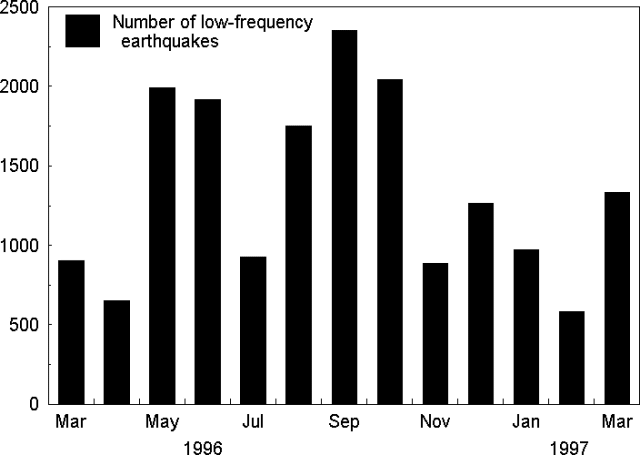Report on Poas (Costa Rica) — March 1997
Bulletin of the Global Volcanism Network, vol. 22, no. 3 (March 1997)
Managing Editor: Richard Wunderman.
Poas (Costa Rica) Relatively stable but seismically active
Please cite this report as:
Global Volcanism Program, 1997. Report on Poas (Costa Rica) (Wunderman, R., ed.). Bulletin of the Global Volcanism Network, 22:3. Smithsonian Institution. https://doi.org/10.5479/si.GVP.BGVN199703-345040
Poas
Costa Rica
10.2°N, 84.233°W; summit elev. 2697 m
All times are local (unless otherwise noted)
Periodic visits revealed that the crater lake level changed as follows compared to December 1996: January, a 31 cm decrease; February, a 55 cm decrease; and March, an 88 cm decrease. Lake-water temperatures during January, February, and March measured 32, 30, and 29°C, respectively. A pH of 1.7 was measured in March. During January-March constant bubbling took place on the lake's S and SW shores. During January and February one fumarole remained noisy; as late as March those on the SE, S, and SW remained at 91- 93°C. The migration of fumaroles was noted in March. Fumarolic gases emitted from the accessible parts of the pyroclastic cone had temperatures of 92°C (January) and 92-93°C (February). Temperatures were not reported for March. During January-March, steam clouds rose 400 m above the crater floor.
Scientists collected acid rain at Cerro Pelón on five days during 7 January-10 March. The respective SO4 and Cl ion concentrations ranged between ~5 and 12 mg/liter, and 1 and 6 mg/liter; pH ranged between 3.5 and 4.5.
A seismic swarm on 31 January consisted of 47 primarily low-frequency earthquakes; some occurred3.0 Hz), 0-99. During the same interval, monthly tremor prevailed for 0-28 hours, peaking in October 1996.
 |
Figure 64. Poás seismicity (at frequencies below 2 Hz) recorded 2.7 km SW of the active crater (station POA2), March 1996 to March 1997. Courtesy of OVSICORI-UNA. |
During January, both the distance network and dry-tilt readings at the summit remained stable. As of March, the three deformation lines across the crater and one external radial line had shown no significant changes during 1997. Another line, from the S side of the overlook (mirador) to the crater bottom, detected a cumulative contraction of 119 ppm/year. This contraction may have come from adjustments due to shallow phreatic venting and an increase in the crater lake's height. Changes in the inclinometer network were not considered significant.
Geological Summary. The broad vegetated edifice of Poás, one of the most active volcanoes of Costa Rica, contains three craters along a N-S line. The frequently visited multi-hued summit crater lakes of the basaltic-to-dacitic volcano are easily accessible by vehicle from the nearby capital city of San José. A N-S-trending fissure cutting the complex stratovolcano extends to the lower N flank, where it has produced the Congo stratovolcano and several lake-filled maars. The southernmost of the two summit crater lakes, Botos, last erupted about 7,500 years ago. The more prominent geothermally heated northern lake, Laguna Caliente, is one of the world's most acidic natural lakes, with a pH of near zero. It has been the site of frequent phreatic and phreatomagmatic eruptions since an eruption was reported in 1828. Eruptions often include geyser-like ejections of crater-lake water.
Information Contacts: E. Fernández, E. Duarte, V. Barboza, R. Van der Laat, E. Hernandez, M. Martinez, and R. Sáenz, Observatorio Vulcanológico y Sismológico de Costa Rica, Universidad Nacional (OVSICORI-UNA).

